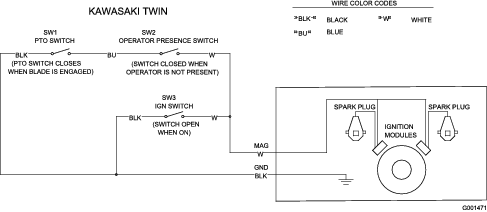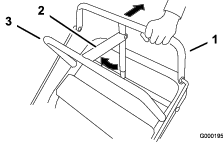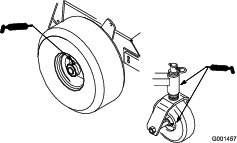| Maintenance Service Interval | Maintenance Procedure |
|---|---|
| Before each use or daily |
|
Introduction
This rotary-blade, lawn mower is intended to be used by residential homeowners or professional, hired operators. It is designed primarily for cutting grass on well-maintained lawns on residential or commercial properties. It is not designed for cutting brush or for agricultural uses.
Read this information carefully to learn how to operate and maintain your product properly and to avoid injury and product damage. You are responsible for operating the product properly and safely.
You may contact Toro directly at www.Toro.com for product safety and operation training materials, accessory information, help finding a dealer, or to register your product.
Whenever you need service, genuine Toro parts, or additional information, contact an Authorized Service Dealer or Toro Customer Service and have the model and serial numbers of your product ready. Figure 1 identifies the location of the model and serial numbers on the product. Write the numbers in the space provided.

This manual identifies potential hazards and has safety messages identified by the safety-alert symbol (Figure 2), which signals a hazard that may cause serious injury or death if you do not follow the recommended precautions.

This manual uses 2 words to highlight information. Important calls attention to special mechanical information and Note emphasizes general information worthy of special attention.
Warning
CALIFORNIA
Proposition 65 Warning
The engine exhaust from this product contains chemicals known to the State of California to cause cancer, birth defects, or other reproductive harm.
Warning
Removing standard original equipment parts and accessories may alter the warranty, traction, and safety of the machine. Failure to use original Toro parts could cause serious injury or death. Making unauthorized changes to the engine, fuel or venting system, may violate EPA and CARB regulations.
Replace all parts including, but not limited to, tires, belts, blades, and fuel system components with original Toro parts.
It is a violation of California Public Resource Code Section 4442 or 4443 to use or operate the engine on any forest-covered, brush-covered, or grass-covered land unless the engine is equipped with a spark arrester, as defined in Section 4442, maintained in effective working order or the engine is constructed, equipped, and maintained for the prevention of fire.
Please refer to the engine manufacturer’s information included with the machine.
Safety
Note: The addition of attachments made by other manufacturers that do not meet American National Standards Institute certification cause noncompliance of this machine.
Improperly using or maintaining the machine can result in injury. To reduce the potential for injury, comply with these safety instructions and always pay attention to the safety alert symbol, which means Caution, Warning, or Danger—personal safety instruction. Failure to comply with the instruction may result in personal injury or death.
Safe Operating Practices
The following instructions are adapted from ANSI B71.4-2012.
Training
-
Read the Operator's Manual and other training material. If the operator(s) or mechanic(s) cannot read or understand the information it is the owner's responsibility to explain this material to them.
-
Become familiar with the safe operation of the equipment, operator controls, and safety signs.
-
All operators and mechanics should be trained. The owner is responsible for training the users.
-
Never let children or untrained people operate or service the equipment. Local regulations may restrict the age of the operator.
-
The owner/user can prevent and is responsible for accidents or injuries occurring to people or damage to property.
Preparation
-
Evaluate the terrain to determine what accessories and attachments are needed to properly and safely perform the job. Use only accessories and attachments approved by the manufacturer.
-
Wear appropriate clothing; including safety glasses, long pants, substantial, slip-resistant footwear, gloves, and hearing protection. Tie back long hair. Do not wear jewelry.
-
Inspect the area where you will use the equipment and remove all objects from the area before using the machine.
-
Use extra care when handling fuels. They are flammable and its vapors are explosive.
-
Use only an approved container.
-
Do not remove the fuel cap or add fuel with the engine running. Allow the engine to cool before refueling. Do not smoke near the machine when the engine is running.
-
Do not refuel or drain the machine indoors.
-
-
Check that the operator's presence controls, safety switches, and shields are attached and functioning properly. Do not operate the machine unless they are functioning properly.
Operation
-
Lightning can cause severe injury or death. If lightning is seen, or thunder is heard in the area, do not operate the machine; seek shelter.
-
Do not run an engine in an enclosed area.
-
Only operate in well-lit areas, keeping away from holes and hidden hazards.
-
Ensure that all drives are in neutral and that the parking brake is engaged before starting engine. Only start the engine from the operator’s position.
-
Make sure that you have good footing while using this machine, especially when backing up.
Note: Reduced footing could cause slipping.
-
Slow down and use extra care on hillsides. Be sure to travel side to side on hillsides. Turf conditions can affect the stability of the machine. Use caution while operating near drop-offs.
-
Slow down and use caution when making turns and when changing directions on slopes.
-
Never raise the deck with the PTO engaged.
-
Never operate with the PTO shield or other guards not securely in place. Be sure all interlocks are attached, adjusted properly, and functioning properly.
-
Never operate with the discharge deflector raised, removed or altered, unless you are using a grass catcher.
-
Do not change the engine governor setting or overspeed the engine.
-
Stop on level ground, disengage drives, engage the parking brake (if provided), and shut off the engine before leaving the operator's position for any reason, including emptying the catchers or unclogging the chute.
-
Shut off the equipment and inspect the blades after striking objects or if an abnormal vibration occurs. Make necessary repairs before resuming operation.
-
Keep your hands and feet away from the cutting unit.
-
Look behind and down before backing up to be sure of a clear path.
-
Never carry passengers on the machine.
-
Keep pets and bystanders away.
-
Slow down and use caution when making turns and crossing roads and sidewalks. Stop the blades if you are not mowing.
-
Be aware of the mower discharge direction and do not point it at anyone.
-
Do not operate the mower while ill, tired, or under the influence of alcohol or drugs.
-
Use care when loading or unloading the machine into or from a trailer or truck.
-
Use care when approaching blind corners, shrubs, trees, or other objects that may obscure vision.
Safe handling of fuels
-
To avoid personal injury or property damage, use extreme care in handling fuel. Fuel is extremely flammable and the vapors are explosive.
-
Extinguish all cigarettes, cigars, pipes, and other sources of ignition.
-
Use only an approved fuel container.
-
Do not remove the fuel cap or add fuel with the engine running.
-
Allow the engine to cool before fueling.
-
Do not fuel the machine indoors.
-
Do not store the machine or fuel container where there is an open flame, spark, or pilot light such as on a water heater or on other appliances.
-
Do not fill containers inside a vehicle, on a truck, or on a trailer bed with a plastic liner. Always place containers on the ground away from your vehicle before filling.
-
Remove equipment from the truck or trailer and fuel it on the ground. If this is not possible, then add fuel with such equipment as a portable container rather than from a fuel-dispenser nozzle.
-
Keep the nozzle in contact with the rim of the fuel tank or container opening at all times until fueling is complete. Do not use a nozzle lock-open device.
-
If fuel is spilled on clothing, change your clothing immediately.
-
Do not overfill the fuel tank. Replace the fuel cap and tighten it securely.
Maintenance and Storage
-
Disengage drives, engage the parking brake, shut off the engine and remove the key or disconnect the spark-plug wire. Wait for all movement to stop before adjusting, cleaning, or repairing the machine.
-
Clean grass and debris from the cutting unit, the drives, the mufflers, and the engine to help prevent fires. Clean up oil or fuel spills.
-
Let the engine cool before storing, and do not store it near a flame.
-
Shut off the fuel while storing or transporting the machine. Do not store fuel near flames or drain it indoors.
-
Park the machine on level ground. Engage the parking brake. Never allow untrained personnel to service the machine.
-
Use jack stands to support components when required.
-
Carefully release pressure from components with stored energy.
-
Disconnect the battery or the spark-plug wire before making any repairs. Disconnect the negative terminal first and the positive last. Connect the positive first and negative last.
-
Use care when checking the blades. Wrap the blade(s) or wear gloves, and use caution when servicing them. Only replace blades. Never straighten or weld them.
-
Keep your hands and feet away from moving parts. If possible, do not make adjustments with the engine running.
-
Keep all parts in good working condition and all hardware tightened. Replace all worn or damaged decals.
-
To best protect your investment and maintain optimal performance of your Toro equipment, count on Toro genuine parts. When it comes to reliability, Toro delivers replacement parts designed to the exact engineering specifications of our equipment. For peace of mind, insist on Toro genuine parts.
Hauling
-
Use care when loading or unloading the machine into a trailer or truck.
-
Use full-width ramps for loading machine into trailer or truck.
-
Tie the machine down securely using straps, chains, cable, or ropes. Both front and rear straps should be directed down and outward from the machine.
Toro Mower Safety
The following list contains safety information specific to Toro products and other safety information you must know.
This product is designed for cutting and recycling grass or, when equipped with a grass bagger, for catching cut grass. Any use for purposes other than these could prove dangerous to you and bystanders.
General Operation
-
Be sure that the area is clear of other people before mowing. Stop the machine if anyone enters the area.
-
Do not touch equipment or attachment parts which may be hot from operation. Allow them to cool before attempting to maintain, adjust, or service them.
-
Use only Toro approved attachments. The warranty may be voided if you use the machine with unapproved attachments.
-
Check carefully for overhead clearances (i.e., branches, doorways, electrical wires) before operating the machine under any objects, and do not contact them.
Slope Operation
All slopes and ramps require extra caution. If you feel uneasy on a slope, do not mow it.
-
Remove obstacles such as rocks, tree limbs, etc. from the mowing area.
-
Watch for holes, ruts, or bumps. Tall grass can hide obstacles.
-
Use caution near drop-offs, ditches, or embankments. The machine could suddenly turn over if a wheel goes over the edge of a cliff or ditch, or if an edge caves in.
-
Use extra care with grass catchers or other attachments. These can change the stability of the machine.
-
Keep all movement on slopes slow and gradual. Do not make sudden changes in speed or direction.
-
Mow slopes side to side.
Service
-
Never store the machine or fuel container inside where there is an open flame, such as near a water heater or furnace.
-
Keep nuts and bolts tight, especially the blade attachment bolts. Keep equipment in good condition.
-
Never tamper with safety devices. Check safety systems for proper operation before each use.
-
Use only genuine replacement parts to ensure that original standards are maintained.
-
Check brake operation frequently. Adjust and service as required.
Safety and Instructional Decals
 |
Safety decals and instructions are easily visible to the operator and are located near any area of potential danger. Replace any decal that is damaged or missing. |

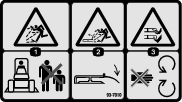



.png)

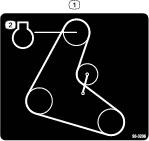






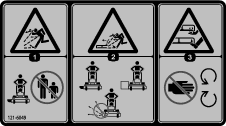

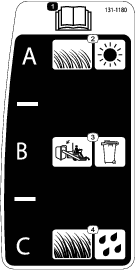




Product Overview
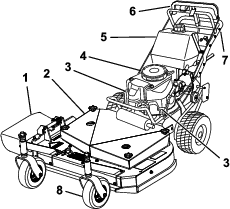
Become familiar with all the controls (Figure 4) before you start the engine and operate the machine.

Throttle Control
The throttle control has 2 positions: FAST and SLOW.
Blade-Control Bail
The bail is used in conjunction with the blade-control lever (PTO) to engage the clutch and drive the mower blades. Releasing the blade-control bail with the PTO engaged shuts off the engine.
Blade-Control Lever (PTO)
This lever is used in conjunction with the blade-control bail to engage and disengage the mower-deck belt and drive the mower blades.
Gear-Shift Lever
The transmission has 5 forward speeds, neutral, reverse, and an in-line shift pattern.
Important: Do not shift gears while the machine is moving, as transmission damage may occur.
Upper Control Bar
Shift to the desired gear and push forward on the upper control bar and blade-control bail to move forward and pull back to brake. Pull back the right side of the upper control bar to turn right and pull back the left side to turn left.
Lower Control Bar
Shift the transmission to reverse and squeeze the lower control bar and handle together to move backward.
Parking-Brake Lever
Pull back the upper control bar and swing the brake lever up against the upper handle to engage the parking brake (Figure 4).
Key Switch
This switch is used in conjunction with recoil starter and has 2 positions: RUN and OFF.
Recoil-Start Handle
Pull the recoil-start handle to start the engine (not shown in Figure 3).
Fuel-Shutoff Valve
Close the fuel-shutoff valve when transporting or storing the machine.
Choke
Use the choke to start a cold engine.
Note: Specifications and design are subject to change without notice.
32-inch Mowers
| Width with deflector down | 116 cm (46 inches) |
| Length | 183 cm (72 inches) |
| Height | 104 cm (41 inches) |
| Weight | 181 kg (400 lb) |
36-inch Mowers
| Width with deflector down | 118 cm (47 inches) |
| Length | 188 cm (74 inches) |
| Height | 104 cm (41 inches) |
| Weight | 209 kg (460 lb) |
Attachments/Accessories
A selection of Toro approved attachments and accessories is available for use with the machine to enhance and expand its capabilities. Contact your Authorized Service Dealer or Distributor or go to www.Toro.com for a list of all approved attachments and accessories.
Operation
Adding Fuel
-
For best results, use only clean, fresh (less than 30 days old), unleaded gasoline with an octane rating of 87 or higher ((R+M)/2 rating method).
-
Ethanol: Gasoline with up to 10% ethanol (gasohol) or 15% MTBE (methyl tertiary butyl ether) by volume is acceptable. Ethanol and MTBE are not the same. Gasoline with 15% ethanol (E15) by volume is not approved for use. Never use gasoline that contains more than 10% ethanol by volume, such as E15 (contains 15% ethanol), E20 (contains 20% ethanol), or E85 (contains up to 85% ethanol). Using unapproved gasoline may cause performance problems and/or engine damage which may not be covered under warranty.
-
Do not use gasoline containing methanol.
-
Do not store fuel either in the fuel tank or fuel containers over the winter unless you use a fuel stabilizer.
-
Do not add oil to gasoline.
Danger
In certain conditions, fuel is extremely flammable and highly explosive. A fire or explosion from fuel can burn you and others and can damage property.
-
Fill the fuel tank outdoors, in an open area, and when the engine is cold. Wipe up any fuel that spills.
-
Never fill the fuel tank inside an enclosed trailer.
-
Do not fill the fuel tank completely full. Add fuel to the fuel tank until the level is 25 mm (1 inch) below the bottom of the filler neck. This empty space in the tank allows the fuel to expand.
-
Never smoke when handling fuel, and stay away from an open flame or where a spark may ignite the fuel fumes.
-
Store fuel in an approved fuel container and keep it out of the reach of children.
-
Never buy more than a 30-day supply of fuel.
-
Do not operate without the entire exhaust system in place and in proper working condition.
Danger
In certain conditions during fueling, static electricity can be released, causing a spark, which can ignite the fuel vapors. A fire or explosion from fuel can burn you and others and can damage property.
-
Always place fuel containers on the ground away from your vehicle before filling.
-
Do not fill fuel containers inside a vehicle or on a truck or trailer bed because interior carpets or plastic truck bed liners may insulate the container and slow the loss of any static charge.
-
When practical, remove fuel-powered equipment from the truck or trailer and refuel the equipment with its wheels on the ground.
-
If this is not possible, then refuel such equipment on a truck or trailer from a portable container rather than from a fuel-dispenser nozzle.
-
If you must use a fuel-dispenser nozzle, keep the nozzle in contact with the rim of the fuel tank or container opening at all times until fueling is complete.
Warning
Fuel is harmful or fatal if swallowed. Long-term exposure to vapors can cause serious injury and illness.
-
Avoid prolonged breathing of vapors.
-
Keep your face away from the nozzle and fuel tank or conditioner bottle opening.
-
Avoid contact with skin; wash off spills with soap and water.
Using Stabilizer/Conditioner
Use a fuel stabilizer/conditioner in the machine to provide the following benefits:
-
Keeps fuel fresh during storage of 90 days or less (drain the fuel tank when storing the machine for more than 90 days)
-
Cleans the engine while it runs
-
Eliminates gum-like varnish buildup in the fuel system, which causes hard starting.
Important: Do not use fuel additives containing methanol or ethanol.
Add the correct amount of fuel stabilizer/conditioner to the fuel.
Note: A fuel stabilizer/conditioner is most effective when mixed with fresh fuel. To minimize the chance of varnish deposits in the fuel system, use fuel stabilizer at all times.
Filling the Fuel Tank
-
Shut off the engine and engage the parking brake.
-
Clean around the fuel-tank cap and remove the cap. Add fuel to the tank, until the level is 6 to 13 mm (1/4 to 1/2 inch) below the bottom of the filler neck.
Note: This space in the tank allows gasoline to expand. Do not fill the fuel tank completely full.
-
Install the fuel-tank cap securely. Wipe up any fuel that may have spilled.
Checking the Engine-Oil Level
Before you start the engine and use the machine, check the oil level in the engine crankcase; refer to Checking the Engine-Oil Level.
Think Safety First
Carefully read all the safety instructions and decals in the safety section. Knowing this information could help you or any bystanders avoid injury.
Caution
This machine produces sound levels in excess of 85 dBA at the operator’s ear and can cause hearing loss through extended periods of exposure.
Wear hearing protection when operating this machine.
Use protective equipment for your eyes, ears, hands, and feet.

Operating the Parking Brake
Stop the machine on level ground, disengage drives, engage the parking brake, shut off the engine, and remove the key. Always engage the parking brake when you shut off the machine or leave it unattended.
Caution
Children or bystanders may be injured if they move or attempt to operate the machine while it is unattended.
Always remove the key and engage the parking brake when leaving the machine unattended, even if just for a few minutes.
Engaging the Parking Brake
Disengaging the Parking Brake
-
Pull the upper control bar rearward. Lower the parking-brake lever to the DISENGAGED position.
-
Gradually release the upper control bar.
Starting the Engine
-
Open the fuel valve.
-
Disengage the blade-control (PTO) lever and move the shift lever to the NEUTRAL position.
-
Engage the parking brake.
-
Turn the key to the RUN position (Figure 7).
-
To start a cold engine, move the throttle control midway between the FAST and SLOW positions.
-
To start a warm engine, move the throttle control to the FAST position.
-
Engage the choke if the engine is cold (Figure 7).
Note: A warm or hot engine usually does not require choking.
-
Grasp the recoil-start handle firmly, pull it until you feel resistance, and then pull the handle vigorously to start the engine.
Note: Allow the rope to recoil slowly.
Important: Do not pull the recoil rope to its limit or release the start handle when you pull the rope; otherwise, the rope may break or you may damage the recoil assembly.
-
Disengage the choke as the engine warms up.
-
If the engine is cold, allow it to warm up and then move the throttle control to the FAST position.
Shutting Off the Engine
Important: In an emergency, you can shut off the engine immediately by turning the key to the OFF position.
-
Move the throttle lever to the SLOW position (Figure 7).
-
Let the engine idle for 30 to 60 seconds before turning the key to the OFF position.
-
Turn the key to the OFF position (Figure 7).
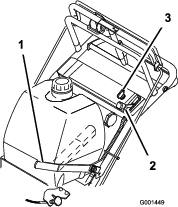
-
Engage the parking brake and remove the key.
-
Disconnect the wires from the spark plugs to prevent the possibility of accidentally starting before storing or performing maintenance on the machine.
-
Close the fuel-shutoff valve before storing or transporting the machine.
Important: Make sure that the fuel-shutoff valve is closed before transporting or storing the machine, as fuel leakage may occur.
Operating the Blade-Control Lever (PTO)
The blade-control lever (PTO) engages and disengages power to the mower blades.
Engaging the Mower Blades
-
To engage the blades, squeeze the blade-control bail against the upper control bar (Figure 8).
-
Push the blade-control lever (PTO) firmly forward, until it latches over-center.
-
Start the engine and repeat the procedure to engage the mower blades if you release the blade-control bail.
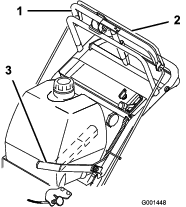
Disengaging the Mower Blades (PTO)
To disengage the blades, pull the blade-control lever (PTO) rearward all the way (Figure 8). The engine shuts off when you release the blade-control bail with the blade-control lever engaged.
Note: It is necessary to fully and manually disengage the blade-control lever.
The Safety-Interlock System
Caution
If the safety-interlock switches are disconnected or damaged, the machine could operate unexpectedly, causing personal injury.
-
Do not tamper with the interlock switches.
-
Check the operation of the interlock switches daily and replace any damaged switches before operating the machine.
The safety-interlock system is designed to prevent the engine from starting when the following occurs:
-
The blade-control lever (PTO) is engaged.
-
The key is in the OFF position.
The safety-interlock system is also designed to shut off the engine when:
-
The-blade-control bail is released with the blade-control lever (PTO) engaged.
-
The key switch is turned to the OFF position.
Testing the Safety-Interlock System
Test the safety-interlock system before you use the machine each time. If the safety system does not operate as described below, have an Authorized Service Dealer repair the safety system immediately.
-
Engage the parking brake, disengage the PTO, and move the throttle forward.
-
Start the engine.
-
With the engine running, squeeze the blade-control bail against upper control bar and push the mower-blade control lever forward.
Note: The mower blades should begin rotating.
-
With the engine running, release the blade-control bail.
Note: The engine should shut off.
-
Start the engine again.
-
With the engine running, turn the key to the OFF position.
Note: The engine should shut off.
Driving Forward or Backward
The throttle control regulates the engine speed as measured in rpm (revolutions per minute). Place the throttle control in the FAST position for best mowing performance.
Driving Forward
-
To move the machine forward, move the shift lever to a forward gear (Figure 9).
-
Disengage the parking brake; refer to Disengaging the Parking Brake.
-
Slowly press the upper control bar to move forward (Figure 9).
To move straight, apply equal pressure to both ends of the upper control bar (Figure 9).
To turn, release pressure on the upper control bar side in the direction you want to turn (Figure 9).
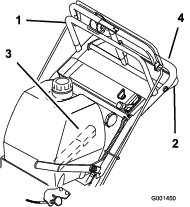
Driving Backward
-
To go backward, move the shift lever to the reverse gear.
-
Disengage the parking brake; refer to Disengaging the Parking Brake.
-
Slowly squeeze the lower control bar and lower handle together to move rearward (Figure 9).
Driving Up a Curb
This procedure can be performed while driving forward or backward.
Note: Some curbs do not allow the rear drive tires to contact the curb. If this happens, drive the machine up the curb at an angle.
Warning
Driving the machine up a curb can bend or damage a blade. Pieces of blade that may be thrown could seriously injure or kill you or bystanders.
Do not engage the blades while driving forward or backward up a curb.
Driving Forward up a Curb
-
Disengage the mower blades.
-
Shift the transmission into first gear to drive the machine.
-
Drive machine until the caster wheels contact the curb (Figure 10).
-
Lift the front of the machine by pushing down on the lower handle (Figure 10).
-
Drive the machine until the drive wheels contact the curb (Figure 10).
-
Lower the front of the machine (Figure 10).
Note: Both drive wheels should contact the curb and the caster wheels should be straight.
-
At the same time, engage the lower control bar and lift up on the lower handle to drive over the curb (Figure 9 and Figure 10).
Note: Lifting up on the lower handle assists driving the machine up a curb and not spin the drive wheels.
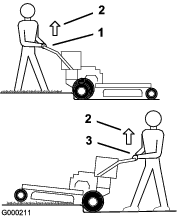
Driving Backward up a Curb
-
Disengage the mower blades.
-
Shift the transmission into reverse to drive the machine.
-
Drive the machine until the drive wheels contact curb (Figure 10).
Note: Both drive wheels should contact the curb and caster wheels should be straight.
-
At the same time, engage the lower control bar and lift up on the lower handle (Figure 9 and Figure 11).
Note: Lifting up on the lower handle assists driving the machine up a curb and does not spin the drive wheels.
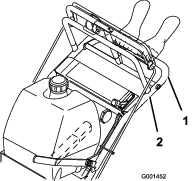
Shutting Off the Machine
To shut off the machine, pull back the upper control bar, release the blade-control bail, turn the key to the OFF position, and engage the parking brake; refer to Engaging the Parking Brake. Remember to remove the key from the key switch.
Caution
Children or bystanders may be injured if they move or attempt to operate the machine while it is unattended.
Always remove the key and engage the parking brake when leaving the machine unattended, even if just for a few minutes.
Transporting the Machine
Use a heavy-duty trailer or truck to transport the machine. Ensure that the trailer or truck has all necessary lighting and marking as required by law. Please carefully read all the safety instructions. Knowing this information could help you, your family, pets or bystanders avoid injury.
-
Shut off the engine, remove the key, engage the parking brake, and close the fuel valve.
-
Securely fasten the machine to the trailer or truck with straps, chains, cable, or ropes.
-
If you are using a trailer, secure the trailer to the towing vehicle and install the safety chains.
Adjusting the Flow Baffle
You can adjust the mower-discharge flow for different types of mowing conditions. Position the baffle to give the best quality of cut.
-
Disengage the PTO and engage the parking brake.
-
Shut off the engine, remove the key, and wait for all moving parts to stop before leaving the operating position.
-
Loosen the nut (Figure 12).
-
Adjust the baffle and nut in the slot to the desired discharge flow and tighten the nut.
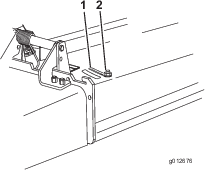
Positioning the Flow Baffle
The following figures are only recommendations for use. Adjustments vary by grass type, moisture content, and height of grass.
Note: If the engine power draws down and the mower ground speed is the same, open the baffle.
Position A
This is the full rear position (see Figure 13). The suggested use for this position is a follows:
-
Use for short, light grass mowing conditions.
-
Use in dry conditions.
-
Use to make smaller grass clippings.
-
Use to propel the grass clippings farther away from the mower.
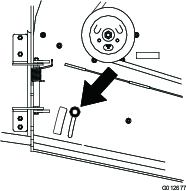
Position B
Use this position when bagging (Figure 14).
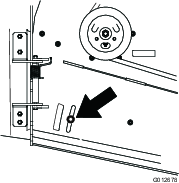
Position C
This is the full open position. The suggested use for this position is as follows (Figure 15):
-
Use in tall, dense grass mowing conditions.
-
Use in wet conditions.
-
Use to lower the engine power consumption.
-
Use at increased ground speed in heavy conditions.
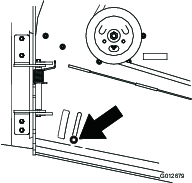
Using the Side Discharge
The mower has a hinged grass deflector that disperses clippings to the side and down toward the turf.
Danger
Without a grass deflector, discharge cover, or a complete grass-catcher assembly mounted in place, you and others are exposed to blade contact and thrown debris. Contact with rotating mower blade(s) and thrown debris will cause injury or death.
-
Never remove the grass deflector from the mower because the grass deflector routes material down toward the turf. If the grass deflector is ever damaged, replace it immediately.
-
Never put your hands or feet under the mower.
-
Never try to clear the discharge area or mower blades unless you move the blade-control switch (PTO) to the OFF position, rotate the ignition key to the OFF position, and remove the key.
-
Make sure that the grass deflector is in the down position.
Adjusting the Height of Cut
This machine has a 26 to 108 mm (1 to 4-1/4 inch) range for the height of cut. Adjust the height of cut by adjusting the blade spacers, rear axle height, and front caster spacers. Use the Height-of-Cut Chart to select the combination of adjustments required.
Adjusting the Blade Height
Adjust the blades by using the 4 spacers on the blade spindle bolts. This allows for a 25 mm (1-inch) adjustment range, in 6 mm (1/4 inch) increments, of cutting height in any axle position. Use the same number of blade spacers on all blades to achieve a level cut (2 above and 2 below, 1 above and 3 below, etc.).
-
Disengage the PTO and engage the parking brake.
-
Shut off the engine, remove the key, and wait for all moving parts to stop before leaving the operating position.
-
Hold the blade bolt and remove the nut (Figure 16).
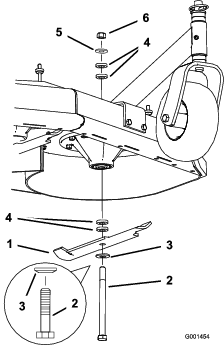
-
Slide the bolt down through the spindle and change the spacers as needed (Figure 16).
-
Install the bolt and curved washer, add extra spacer(s), and secure them with a thin washer and a nut (Figure 16).
-
Torque the blade bolt to 101 to 108 N∙m (75 to 80 ft-lb).
Adjusting the Axle Height
Adjust the axle position to the selected height-of-cut setting. Refer to Height-of-Cut Chart.
-
Disengage the PTO and engage the parking brake.
-
Shut off the engine, remove the key, and wait for all moving parts to stop before leaving the operating position.
-
Loosen, but do not remove, the 2 axle pivot bolts and the 2 axle adjustment bolts (Figure 17).
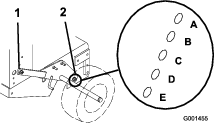
-
Place a jack under the rear center of the engine frame. Raise the back end of the engine frame up enough to remove the front 2 axle adjustment bolts (Figure 17).
Note: Use jack stands to support the machine.
-
Raise or lower the engine frame with the jack so that you can install the front 2 axle adjustment bolts in the desired hole location (Figure 17).
Note: Use a tapered punch to help align the holes.
-
Tighten all 4 bolts and lower the mower.
-
Adjust the control rods and the brake linkages as required. Refer to Adjusting the Control Rods and Servicing the Brakes.
Important: You must adjust the control rods and the brake linkage when you change the axle positions for proper traction and brake function.
Adjusting the Caster Position
-
Using the Height-of-Cut Chart, adjust the caster spacers to match with the axle hole selected (Figure 18).
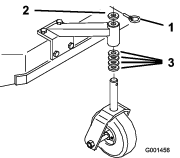
-
Remove the latch pin, slide the caster from the support, and change the spacers (Figure 18).
-
Install the caster in the support and insert the latch pin (Figure 18).
Adjusting the Handle Height
You can adjust the handle position to match your height preference.
-
Remove hairpin cotter, washer, and clevis pin securing the control-rod fitting to the idler bracket (Figure 19).
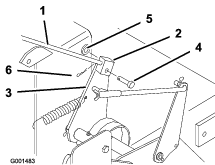
-
Loosen the upper flange bolts (3/8 x 1 inch) and flange nut (3/8 inch) securing the handle to the rear frame (Figure 20).
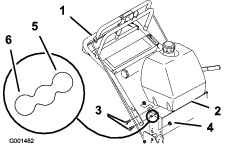
-
Remove the lower flange bolts (3/8 x 1 inch) and flange nuts (3/8 inch) securing handle to rear frame (Figure 20).
-
Pivot the handle to the desired operating position and install the lower flange bolts (3/8 x 1 inch) and flange nuts (3/8 inch) into the mounting holes.
Note: Tighten all the flange bolts.
-
Thread the rod fitting up or down on the rod until you achieve the proper position and install the fitting to the idler bracket with the clevis pin, washer, and hairpin cotter.
-
Check the parking-brake adjustment. Refer to Checking the Brakes.
Adjusting the Control Rods
-
With the wheel drive fully engaged, check the gap between the upper control bar and the fixed bar. The gap needs to be approximately 25 to 32 mm (1 to 1-1/4 inches); refer to Figure 21.

Note: The upper control bar and the fixed bar must be parallel in the engaged, relaxed, and brake positions.
-
Check the operation of the upper control bar. If it needs adjustment, continue as follows:
-
Remove the hairpin cotter securing the control rod to the upper control bar.
-
Thread the rod in or out of the control-rod fitting for proper position and install the control rod into the upper control bar with the hairpin cotter.
-
-
After adjusting the control rods, check the parking-brake adjustment; Checking the Brakes.
Height-of-Cut Chart
| Axle position | Number of spacers below the caster | Number of 1/4-inch blade spacers below the spindle | |||||
| 13 mm | 5 mm | 4 | 3 | 2 | 1 | 0 | |
| (1/2 inch) | (3/16 inch) | ||||||
| A | 0 | 0 | 26 mm | 32 mm | 38 mm | 45 mm | 51 mm |
| (1 inch) | (1-1/4 inch) | (1-1/2 inch) | (1-3/4 inch) | (2 inch) | |||
| A | 0 | 1 | 29 mm | 35 mm | 41 mm | 48 mm | 54 mm |
| (1-1/8 inch) | (1-3/8 inch) | (1-5/8 inch) | (1-7/8 inch) | (2-1/8 inch) | |||
| A | 1 | 0 | 35 mm | 41 mm | 48 mm | 54 mm | 60 mm |
| (1-3/8 inch) | (1-5/8 inch) | (1-7/8 inch) | (2-1/8 inch) | (2-3/8 inch) | |||
| B | 0 | 1 | 35 mm | 41 mm | 48 mm | 54 mm | 60 mm |
| (1-3/8 inch) | (1-5/8 inch) | (1-7/8 inch) | (2-1/8 inch) | (2-3/8 inch) | |||
| B | 1 | 0 | 41 mm | 48 mm | 54 mm | 60 mm | 67 mm |
| (1-5/8 inch) | (1-7/8 inch) | (2-1/8 inch) | (2-3/8 inch) | (2-5/8 inch) | |||
| B | 1 | 1 | 45 mm | 51 mm | 57 mm | 64 mm | 70 mm |
| (1-3/4 inch) | (2 inch) | (2-1/4 inch) | (2-1/2 inch) | (2-3/4 inch) | |||
| B | 2 | 0 | 51 mm | 57 mm | 64 mm | 70 mm | 76 mm |
| (2 inch) | (2-1/4 inch) | (2-1/2 inch) | (2-3/4 inch) | (3 inch) | |||
| C | 1 | 1 | 48 mm | 54 mm | 60 mm | 67 mm | 73 mm |
| (1-7/8 inch) | (2-1/8 inch) | (2-3/8 inch) | (2-5/8 inch) | (2-7/8 inch) | |||
| C | 2 | 0 | 55 mm | 60 mm | 67 mm | 73 mm | 79 mm |
| (2-1/8 inch) | (2-3/8 inch) | (2-5/8 inch) | (2-7/8 inch) | (3-1/8 inch) | |||
| C | 2 | 1 | 57 mm | 64 mm | 70 mm | 76 mm | 83 mm |
| (2-1/4 inch) | (2-1/2 inch) | (2-3/4 inch) | (3 inch) | (3-1/4 inch) | |||
| C | 3 | 0 | 64 mm | 70 mm | 76 mm | 83 mm | 89 mm |
| (2-1/2 inch) | (2-3/4 inch) | (3 inch) | (3-1/4 inch) | (3-1/2 inch) | |||
| D | 2 | 1 | 61 mm | 67 mm | 73 mm | 79 mm | 86 mm |
| (2-3/8 inch) | (2-5/8 inch) | (2-7/8 inch) | (3-1/8 inch) | (3-3/8 inch) | |||
| D | 3 | 0 | 64 mm | 70 mm | 76 mm | 82 mm | 89 mm |
| (2-1/2 inch) | (2-3/4 inch) | (3 inch) | (3-1/4 inch) | (3-1/2 inch) | |||
| D | 3 | 1 | 70 mm | 76 mm | 82 mm | 89 mm | 95 mm |
| (2-3/4 inch) | (3 inch) | (3-1/4 inch) | (3-1/2 inch) | (3-3/4 inch) | |||
| D | 4 | 0 | 76 mm | 82 mm | 89 mm | 95 mm | 102 mm |
| (3 inch) | (3-1/4 inch) | (3-1/2 inch) | (3-3/4 inch) | (4 inch) | |||
| E | 3 | 1 | 73 mm | 79 mm | 86 mm | 92 mm | 98 mm |
| (2-7/8 inch) | (3-1/8 inch) | (3-3/8 inch) | (3-5/8 inch) | (3-7/8 inch) | |||
| E | 4 | 0 | 79 mm | 86 mm | 92 mm | 98 mm | 105 mm |
| (3-1/8 inch) | (3-3/8 inch) | (3-5/8 inch) | (3-7/8 inch) | (4-1/8 inch) | |||
| E | 4 | 1 | 82 mm | 89 mm | 95 mm | 102 mm | 108 mm |
| (3-1/4 inch) | (3-1/2 inch) | (3-3/4 inch) | (4 inch) | (4-1/4 inch) | |||
Maintenance
Note: Determine the left and right sides of the machine from the normal operating position.
Recommended Maintenance Schedule(s)
| Maintenance Service Interval | Maintenance Procedure |
|---|---|
| After the first 8 hours |
|
| After the first 25 hours |
|
| Before each use or daily |
|
| Every 25 hours |
|
| Every 50 hours |
|
| Every 100 hours |
|
| Every 200 hours |
|
| Every 250 hours |
|
| Every 400 hours |
|
| Before storage |
|
Important: Refer to your engine owner's manual for additional maintenance procedures.
Caution
If you leave the key in the switch, someone could accidently start the engine and seriously injure you or other bystanders.
Remove the key from the switch and disconnect the spark-plug wire(s) from the spark plug(s) before you do any maintenance. Set the wire aside so that it does not accidentally contact the spark plug.
Lubrication
Grease Type: #2 lithium or molybdenum grease
Lubricating the Machine
-
Disengage the PTO and engage the parking brake.
-
Shut off the engine, remove the key, and wait for all moving parts to stop before leaving the operating position.
-
Clean the grease fittings with a rag. Make sure to scrape any paint off the front of the fitting(s).
-
Connect a grease gun to the fitting. Pump grease into the fittings until grease begins to ooze out of the bearings.
-
Wipe up any excess grease.
Lubricating the Caster and Wheel Bearings
| Maintenance Service Interval | Maintenance Procedure |
|---|---|
| Before each use or daily |
|
| Every 400 hours |
|
Greasing the Transmission Couplers
| Maintenance Service Interval | Maintenance Procedure |
|---|---|
| Every 250 hours |
|
Lubricate the transmission couplers and idler arm pivots located in the back of the machine (Figure 23).
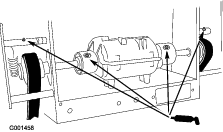
Greasing the Mower Belt Idler
| Maintenance Service Interval | Maintenance Procedure |
|---|---|
| Every 50 hours |
|
Grease the fitting on the mower belt-idler arm pivot (Figure 24).
Note: Remove the mower-deck cover to access the grease fitting for the mower belt-idler arm.

Engine Maintenance
Servicing the Air Cleaner
| Maintenance Service Interval | Maintenance Procedure |
|---|---|
| Every 25 hours |
|
| Every 50 hours |
|
| Every 200 hours |
|
Important: Do not oil the foam or paper element.
Removing the Foam and Paper Elements
-
Disengage the PTO and engage the parking brake.
-
Shut off the engine, remove the key, and wait for all moving parts to stop before leaving the operating position.
-
Clean around the air cleaner to prevent dirt from getting into the engine and causing damage ().
-
Unscrew the cover knobs and remove the air-cleaner cover ().
-
Unscrew the hose clamp and remove the air-cleaner assembly ().
-
Carefully pull the foam element off the paper element ().
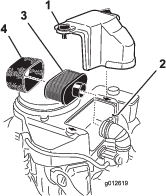
Cleaning the Foam Air-Cleaner Element
-
Wash the foam element in liquid soap and warm water. When the element is clean, rinse it thoroughly.
-
Dry the element by squeezing it in a clean cloth.
Important: Replace the foam element if it is torn or worn.
Servicing the Paper Air-Cleaner Element
-
Clean the paper element by tapping it gently to remove dust. If it is very dirty, replace the paper element with a new one (Figure 25).
-
Inspect the element for tears, an oily film, or damage to the rubber seal.
-
Replace the paper element if it is damaged.
Important: Do not clean the paper filter.
Installing the Foam and Paper Air-Cleaner Elements
Important: To prevent engine damage, always operate the engine with the complete foam and paper air-cleaner assembly installed.
Servicing the Engine Oil
Oil Type: Detergent oil (API service SF, SG, SH, SJ or SL)
Crankcase Capacity: 1.7 L (57 fl oz) with the filter removed; 1.5 L (51 fl oz) without the filter removed
Viscosity: Refer to the table (Figure 26).
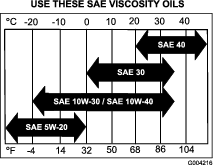
Checking the Engine-Oil Level
| Maintenance Service Interval | Maintenance Procedure |
|---|---|
| Before each use or daily |
|
-
Disengage the PTO and engage the parking brake.
-
Shut off the engine, remove the key, and wait for all moving parts to stop before leaving the operating position.
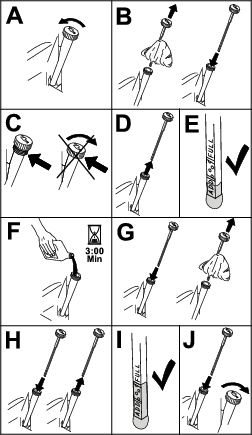
Changing the Engine Oil
| Maintenance Service Interval | Maintenance Procedure |
|---|---|
| After the first 8 hours |
|
| Every 100 hours |
|
-
Park the machine so that the drain side is slightly lower than the opposite side to ensure that the oil drains completely.
-
Disengage the PTO and engage the parking brake.
-
Shut off the engine, remove the key, and wait for all moving parts to stop before leaving the operating position.
-
Drain the oil from the engine (Figure 28).
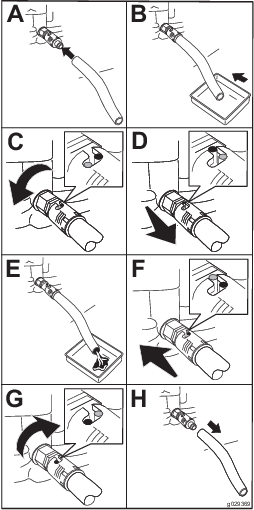
-
Slowly pour approximately 80% of the specified oil into the filler tube (Figure 29).

Changing the Oil Filter
| Maintenance Service Interval | Maintenance Procedure |
|---|---|
| Every 200 hours |
|
-
Drain the oil from the engine; refer to Changing the Engine Oil.
-
Change the engine-oil filter (Figure 30).
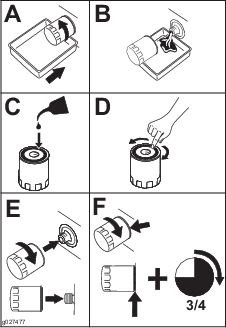
Note: Ensure that the oil-filter gasket touches the engine, and then turn the oil filter an extra 3/4 turn.
-
Fill the crankcase with the proper type of new oil; refer to Servicing the Engine Oil.
Servicing the Spark Plugs
| Maintenance Service Interval | Maintenance Procedure |
|---|---|
| Every 100 hours |
|
Make sure that the air gap between the center and side electrodes is correct before installing the spark plug. Use a spark plug wrench for removing and installing the spark plug(s) and a gapping tool/feeler gauge to check and adjust the air gap. Install a new spark plug(s) if necessary.
Type: NGK® BPR4ES or equivalent
Air Gap: 0.75 mm (0.030 inch)
Removing the Spark Plugs
-
Disengage the PTO and engage the parking brake.
-
Shut off the engine, remove the key, and wait for all moving parts to stop before leaving the operating position.
-
Remove the spark plugs as shown in (Figure 31).
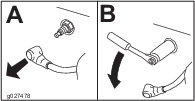
Checking the Spark Plugs
Important: Do not clean the spark plugs. Always replace the spark plugs when they have: a black coating, worn electrodes, an oily film, or cracks.
If you see light brown or gray on the insulator, the engine is operating properly. A black coating on the insulator usually means the air cleaner is dirty.
Set the gap to 0.75 mm (0.03 inch).
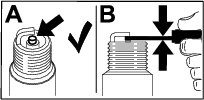
Installing the Spark Plugs
Tighten the spark plugs to 22 N∙m (16 ft-lb).
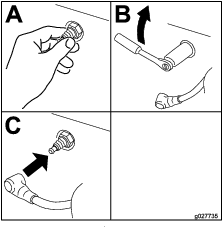
Fuel System Maintenance
Servicing the Fuel System
Danger
In certain conditions, fuel is extremely flammable and highly explosive. A fire or explosion from fuel can burn you and others and can damage property.
-
Drain fuel from the fuel tank when the engine is cold. Do this outdoors in an open area. Wipe up any fuel that spills.
-
Never smoke when draining fuel, and stay away from an open flame or where a spark may ignite the fuel fumes.
Draining the Fuel Tank
-
Park the machine on a level surface to ensure that the fuel tank drains completely.
-
Disengage the PTO and engage the parking brake.
-
Shut off the engine, remove the key, and wait for all moving parts to stop before leaving the operating position.
-
Close the fuel-shutoff valve at the fuel tank (Figure 34).
-
Squeeze the ends of the hose clamp together and slide it up the fuel line away from fuel filter (Figure 34).
-
Pull the fuel line off the fuel filter (Figure 34).
-
Open the fuel-shutoff valve and allow the fuel to drain into a fuel can or drain pan.
Note: Now is the best time to install a new fuel filter because the fuel tank is empty. Refer to Replacing the Fuel Filter.
-
Install the fuel line onto the fuel filter. Slide the hose clamp close to the valve to secure the fuel line.
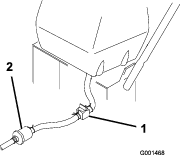
Replacing the Fuel Filter
| Maintenance Service Interval | Maintenance Procedure |
|---|---|
| Every 200 hours |
|
Never install a dirty filter if it is removed from the fuel line.
Note: Note how the fuel filter is installed in order to install the new filter correctly.
Note: Wipe up any spilled fuel.
-
Disengage the PTO and engage the parking brake.
-
Shut off the engine, remove the key, and wait for all moving parts to stop before leaving the operating position.
-
Close the fuel-shutoff valve at the fuel tank (Figure 34).
-
Replace the filter as shown in Figure 35.
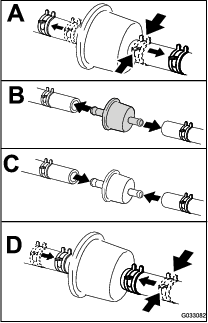
-
Open the fuel-shutoff valve (Figure 34).
Servicing the Fuel-Vent System
| Maintenance Service Interval | Maintenance Procedure |
|---|---|
| Every 200 hours |
|
-
Disengage the PTO and engage the parking brake.
-
Shut off the engine, remove the key, and wait for all moving parts to stop before leaving the operating position.
-
Remove the existing fuel-vent filter (Figure 36).
-
Install a new filter.
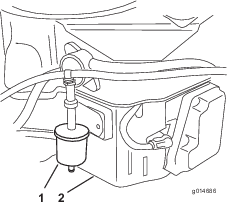
Drive System Maintenance
Checking the Tire Pressure
| Maintenance Service Interval | Maintenance Procedure |
|---|---|
| Every 50 hours |
|
Maintain the air pressure in the rear tires at 83 to 97 kPa (12 to 14 psi). Uneven tire pressure can cause an uneven cut.
Note: The front tires are semi-pneumatic tires and do not require air-pressure maintenance.
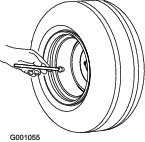
Cooling System Maintenance
Cleaning the Air-Intake Screen
| Maintenance Service Interval | Maintenance Procedure |
|---|---|
| Before each use or daily |
|
Before each use, remove any buildup of grass, dirt, or other debris from the cylinder and cylinder-head cooling fins, air-intake screen on the flywheel end, and the carburetor-governor levers and linkage. This helps ensure that adequate cooling and correct engine speed, and reduces the possibility of overheating or mechanical damage to the engine.
Cleaning the Cooling System
| Maintenance Service Interval | Maintenance Procedure |
|---|---|
| Before each use or daily |
|
| Every 100 hours |
|
-
Disengage the PTO and engage the parking brake.
-
Shut off the engine, remove the key, and wait for all moving parts to stop before leaving the operating position.
-
Remove the air-intake screen, the recoil-start handle, and the fan housing (Figure 38).
-
Clean the debris and grass from the engine parts.
-
Install the air-intake screen, the recoil-start handle, and the fan housing (Figure 38).
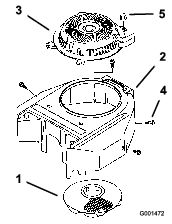
Brake Maintenance
Servicing the Brakes
Before each use, check the brakes on both a level surface and slope.
Always engage the parking brake when you shut off the machine or leave it unattended. If the parking brake does not hold securely, adjust it.
Checking the Brakes
| Maintenance Service Interval | Maintenance Procedure |
|---|---|
| Before each use or daily |
|
-
Park the machine on a level surface and disengage the PTO.
-
Shut off the engine, remove the key, and wait for all moving parts to stop before leaving the operating position.
-
Engage the parking brake.
Note: The wheels must lock when you try to push the machine forward.
-
If the wheels do not lock, adjust the brakes. Refer to Adjusting the Brakes.
-
Disengage the brake and press upper control bar very lightly, approximately 13 mm (1/2 inch).
Note: The wheels should rotate freely; if not, refer to Adjusting the Brakes.
Adjusting the Brakes
If the parking brake does not hold securely, an adjustment is required.
-
Park the machine on a level surface, disengage the PTO, and engage the parking brake.
-
Shut off the engine, remove the key, and wait for all moving parts to stop before leaving the operating position.
-
Check the brake before you adjust it; refer to Checking the Brakes.
-
Disengage the parking brake; refer to Disengaging the Parking Brake.
-
To adjust the brake, rotate the wing nuts on the brake rods (Figure 39).
Note: Turn the wing nuts clockwise to tighten the brake and counterclockwise to loosen the brake.
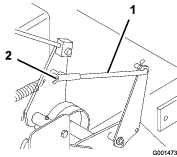
Note: Control bar should be parallel with the reference bar when properly adjusted.
-
Check the brake operation again; refer to Checking the Brakes.
Important: With the parking brake released, the rear wheels must rotate freely when you push the mower. If the wheels do not lock when you engage the parking brake or if they do not rotate freely when you disengage the parking brake, contact your service dealer immediately.
Belt Maintenance
Checking the Belts
| Maintenance Service Interval | Maintenance Procedure |
|---|---|
| Every 50 hours |
|
Check the belts for cracks, frayed edges, burn marks, wear, signs of overheating, or any other damage. Replace any damaged belts.
Replacing the Traction Drive Belt
-
Remove the hairpin cotter securing the brake rod to the brake arm to relax the tension on the belt idler (Figure 40).
-
Remove the bottom bolt and loosen the top bolt of the shield to rotate it for belt clearance (Figure 40).
-
Lift the belt past the idler and off the drive pulley (Figure 40).
-
Raise the wheel off the ground enough to remove the belt.
-
Replace the traction-drive belt.
-
Secure the shield with the previously removed bolt and tighten the bolts (Figure 40).
-
Secure the brake rod to the brake arm with the hairpin cotter (Figure 40).

Replacing the Drive Belt
-
Disengage the PTO and engage the parking brake.
-
Shut off the engine, remove the key, and wait for all moving parts to stop before leaving the operating position.
-
Raise the rear of the machine and hold it up with jack stands.
-
Remove the mower belt (Figure 41).
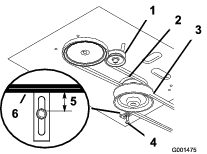
-
Loosen the pivot bolt enough to slide the idler pulley in the slot, and remove the traction belt from the engine and the drive pulleys (Figure 41).
-
Install the new drive belt around the engine and the drive pulleys (Figure 41).
-
Slide the idler pulley in the engine frame to tension the traction belt (Figure 41).
-
Install the mower belt (Figure 41).
-
Check the belt guide under the engine frame for the proper adjustment (Figure 41).
Note: The distance between the belt guide and mower belt should be 19 mm (3/4 inch) when you engage the mower belt. Adjust the belt if necessary. The disengaged belt should not drag or fall off the pulley when the guides are properly adjusted.
Replacing the Mower Belt
Important: The brake needs to be adjusted when the belt tension or the brake linkage is adjusted.
-
Disengage the PTO and engage the parking brake.
-
Shut off the engine, remove the key, and wait for all moving parts to stop before leaving the operating position.
-
Remove the knobs and the belt cover on the mower.
-
Remove the idler pulley and the worn belt.
-
Install the new mower belt.
-
Install the idler pulley.
-
Engage the PTO and check the belt tension. Refer to Adjusting the Mower Belt Tension.
Note: The proper mower belt tension is 44 to 67 N∙m (10 to 15 ft-lb) with the belt deflected 13 mm (1/2 inch) halfway between the pulleys (Figure 44).
-
Engage the PTO.
-
Check the clearance between the bell crank and the transmission output shaft (Figure 42).
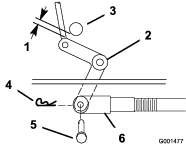
Note: The clearance should be 2 to 3 mm (1/16 to 1/8 inch).
-
Remove the hairpin cotter and the clevis pin from the bell crank.
-
Rotate the clevis clockwise on the rod to increase the clearance; rotate it counterclockwise to decrease it (Figure 42).
-
Disengage the PTO.
Note: If the assist arm does not contact the front stop on the mower deck (Figure 43), adjust the clevis to bring the bell crank closer to the transmission output shaft (Figure 42).

-
Check the belt guide under the engine frame for the proper adjustment (Figure 41).
Note: The distance between the belt guide and the mower belt should be 32 mm (1-1/4 inch) when you engage the mower belt. Adjust the mower belt as necessary. The disengaged belt should not drag or fall off the pulley when the guides are properly adjusted.
Adjusting the Mower Belt Tension
| Maintenance Service Interval | Maintenance Procedure |
|---|---|
| After the first 8 hours |
|
| After the first 25 hours |
|
| Every 50 hours |
|
Important: Adjust the brake when you adjust the belt tension or the brake linkage.
Important: The belt must be tight enough to not slip during heavy loads while cutting grass. Overtensioning the belt reduces the life of the spindle bearing, the belt, and the idler pulley.
-
Disengage the PTO and engage the parking brake.
-
Shut off the engine, remove the key, and wait for all moving parts to stop before leaving the operating position.
-
Loosen the locknut on the turnbuckle (Figure 44).
-
Rotate the turnbuckle toward the rear of the mower to increase the tension on the belt. Rotate the turnbuckle toward the front of the mower to decrease the tension on the belt (Figure 44).
Note: The eyebolt threads on both ends of the turnbuckle should be engaged a minimum of 8 mm (5/16 inch).
-
Engage the PTO and check the belt tension. Adjust tension until it is correct.
Note: The proper mower belt tension is 44 to 67 N∙m (10 to 15 ft-lb) with the belt deflected 13 mm (1/2 inch) halfway between the pulleys (Figure 44).

-
Tighten the locknut on the turnbuckle.
-
Check the blade-brake adjustment; refer to Adjusting the Blade Brake.
Adjusting the PTO-Engagement Linkage
The PTO-engagement linkage adjustment is located beneath the front left-hand corner of the engine deck.
-
Disengage the PTO and engage the parking brake.
-
Shut off the engine, remove the key, and wait for all moving parts to stop before leaving the operating position.
-
Engage the PTO lever.
-
Adjust the linkage length so that the lower end of the bellcrank just clears the axle support gusset (Figure 45).
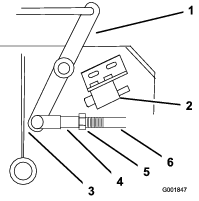
-
Make sure that the assist arm is against the rear assist-arm stop on the deck (Figure 46).
-
Push the blade-control lever (PTO) down to the disengaged position.
-
The assist arm should contact the front assist-arm stop on the deck. If it does not contact the stop, adjust the bellcrank so that it is closer to the gusset (Figure 46).

-
To adjust the assist-arm link, remove the hairpin cotter from the assist arm (Figure 46).
-
Loosen the nut against the yoke (Figure 45).
-
Remove the assist-arm link from the assist arm and rotate the link to adjust the length.
-
Install the assist-arm link into the assist arm and secure it with the hairpin cotter (Figure 46).
-
Check if the assist arm contacts the stops correctly.
Adjusting the PTO Safety Switch
-
Disengage the blade-control (PTO) lever and engage the parking brake.
-
Shut off the engine and wait for all moving parts to stop before leaving the operating position.
-
Verify that the assist arm is against the front assist-arm stop.
-
If needed, adjust the blade-safety switch by loosening the bolts holding the switch bracket (Figure 47).
-
Move the mounting bracket until the bellcrank presses the plunger by 6 mm (1/4 inch); refer to (Figure 47).
Note: Make sure that the bellcrank does not touch the switch body; otherwise, damage to the switch could occur.
-
Tighten the switch mounting bracket.
Mower Deck Maintenance
Servicing the Cutting Blades
To ensure a superior quality of cut, keep the blades sharp. For convenient sharpening and replacement, keep extra blades on hand.
Warning
A worn or damaged blade can break, and a piece of the blade could be thrown at you or bystanders, resulting in serious personal injury or death.
-
Inspect the blades periodically for wear or damage.
-
Replace a worn or damaged blade.
Preparing to Inspect or Service the Blades
-
Disengage the PTO and engage the parking brake.
-
Shut off the engine, remove the key, and wait for all moving parts to stop before leaving the operating position.
-
Disconnect the spark-plug wires from the spark plugs.
Inspecting the Blades
| Maintenance Service Interval | Maintenance Procedure |
|---|---|
| Before each use or daily |
|
-
Inspect the cutting edges (Figure 47).
-
If the edges are not sharp or have nicks, remove and sharpen the blade; refer to Sharpening the Blades.
-
Inspect the blades, especially in the curved area.
-
If you notice any cracks, wear, or a slot forming in this area, immediately install a new blade (Figure 47).

Checking for Bent Blades
-
Disengage the PTO and engage the parking brake.
-
Shut off the engine, remove the key, and wait for all moving parts to stop before leaving the operating position.
-
Rotate the blades until the ends face forward and backward (Figure 49).

-
Measure from a level surface to the cutting edge, position A, of the blades (Figure 50).
Note: Note this dimension.

-
Rotate the opposite ends of the blades forward.
-
Measure from a level surface to the cutting edge of the blades at the same position as in step 3.
Note: The difference between the dimensions obtained in steps 3 and 4 must not exceed 3 mm (1/8 inch). If this dimension exceeds 3 mm (1/8 inch), the blade is bent and must be replaced. Refer to Removing the Blades and Installing the Blades.
Warning
A blade that is bent or damaged could break apart and could critically injure you or bystanders.
-
Always replace a bent or damaged blade with a new blade.
-
Do not file or create sharp notches in the edges or surfaces of the blade.
-
Removing the Blades
Replace the blades if you hit a solid object or if the blades are out of balance or bent. To ensure optimum performance and continued safety conformance of the machine, use genuine Toro replacement blades. Replacement blades made by other manufacturers may result in non-conformance with safety standards.
-
Hold the blade bolt with a wrench.
-
Remove the nut, blade bolt, curved washer, blade, spacers, and thin washer from the spindle (Figure 51).

Sharpening the Blades
-
Use a file to sharpen the cutting edge at both ends of the blade (Figure 52).
Note: Maintain the original angle. The blade remains balanced if the same amount of material is removed from both cutting edges.

-
Check the balance of the blade by putting it on a blade balancer (Figure 53).
Note: If the blade stays in a horizontal position, the blade is balanced and can be used. If the blade is not balanced, file some metal off the end of the sail area only (Figure 53). Repeat this procedure until the blade is balanced.

Installing the Blades
-
Install the curved washer and then the blade onto the bolt. Select the proper number of spacer(s) for the height of cut, and slide the bolt into the spindle (Figure 51).
Important: The curved part of the blade must point upward toward the inside of the mower to ensure proper cutting.
-
Install the remaining spacer(s) and secure them with a thin washer and a nut (Figure 51).
-
Torque the blade bolt to 101 to 108 N∙m (75 to 80 ft-lb).
Adjusting the Blade Brake
-
Disengage the PTO and engage the parking brake.
-
Shut off the engine, remove the key, and wait for all moving parts to stop before leaving the operating position.
-
If necessary, adjust the spring mounting bolts so that the blade brake pad rubs against both sides of the pulley groove (Figure 54).
-
Adjust the nut at the end of the blade brake rod until there is 3 mm to 5 mm (1/8 to 3/16 inch) between the nut and the spacer (Figure 54).
-
Engage the blades.
Note: Ensure that the blade brake pad no longer contacts the pulley groove.
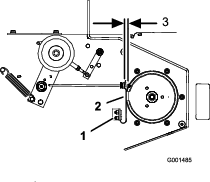
Replacing the Grass Deflector
Warning
An uncovered discharge opening could allow the machine to throw objects toward you or bystanders, resulting in serious injury. Also, contact with the blade could occur.
Do not operate the machine unless you install a cover plate, a mulch plate, grass deflector, or bagger.
-
Remove the locknut, bolt, spring, and spacer holding the deflector to the pivot brackets (Figure 54).
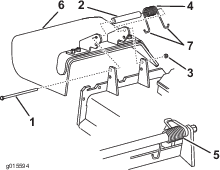
-
Remove the damaged or worn grass deflector.
-
Place the spacer and the spring onto the grass deflector.
-
Place 1 J-hook end of the spring behind the deck edge.
Note: Make sure that 1 J-hook end of spring is installed behind deck edge before installing the bolt as shown in Figure 54.
-
Install the bolt and the nut.
-
Place 1 J-hook end of the spring around the grass deflector (Figure 54).
Important: The grass deflector must be able to rotate. Lift the deflector up to the full open position, and ensure that it rotates into the full down position.
Storage
-
Disengage the PTO and engage the parking brake.
-
Shut off the engine, remove the key, and wait for all moving parts to stop before leaving the operating position.
-
Remove grass clippings, dirt, and grime from the external parts of the entire machine, especially the engine. Clean dirt and chaff from the outside of the engine cylinder-head fins and the blower housing.
Important: You can wash the machine with mild detergent and water. Do not pressure-wash the machine. Avoid excessive use of water, especially near the shift-lever plate and the engine.
-
Check the brakes; refer to Checking the Brakes.
-
Service the air cleaner; refer to Servicing the Air Cleaner.
-
Grease and lubricate the machine; refer to Lubrication.
-
Change the engine oil; refer to Changing the Engine Oil.
-
Check the tire pressure; refer to Checking the Tire Pressure.
-
For long-term storage:
-
Add stabilizer/conditioner additive to fuel in the tank.
-
Run the engine to distribute conditioned fuel through the fuel system (5 minutes).
-
Shut off the engine, allow it to cool, and drain the fuel tank; refer to Draining the Fuel Tank, or operate the engine until it stops.
-
Start the engine and run it until it stops. Repeat the process, with the choke on, until the engine does not start.
-
Dispose of fuel properly. Recycle it according to local codes.
Note: Do not store stabilizer/conditioned gasoline over 90 days.
-
-
Condition the engine for storage as follows:
-
Remove the spark plug(s) and check the condition; refer to Servicing the Spark Plugs.
-
Pour 2 tablespoons of engine oil into the engine through each spark-plug hole.
-
Rotate the engine using the starter of the machine.
Note: Rotating the engine distributes the oil inside the cylinder.
-
Install the spark plug(s).
Note: Do not connect the spark-plug wires to the spark plugs.
-
-
Check and tighten all bolts, nuts, and screws. Repair or replace any part that is damaged or worn.
-
Paint all scratched or bare metal surfaces with paint available from your Authorized Service Dealer.
-
Store the machine in a clean, dry garage or storage area. Remove the key from the switch and keep it in a memorable place. Cover the machine to protect it and keep it clean.
Troubleshooting
| Problem | Possible Cause | Corrective Action |
|---|---|---|
| The engine does not start, starts hard, or fails to keep running. |
|
|
| The engine loses power. |
|
|
| The engine overheats. |
|
|
| The machine does not drive. |
|
|
| There is abnormal vibration. |
|
|
| The machine produces an uneven cutting height. |
|
|
| The blades do not rotate. |
|
|
Schematics
Electrical Schematic
